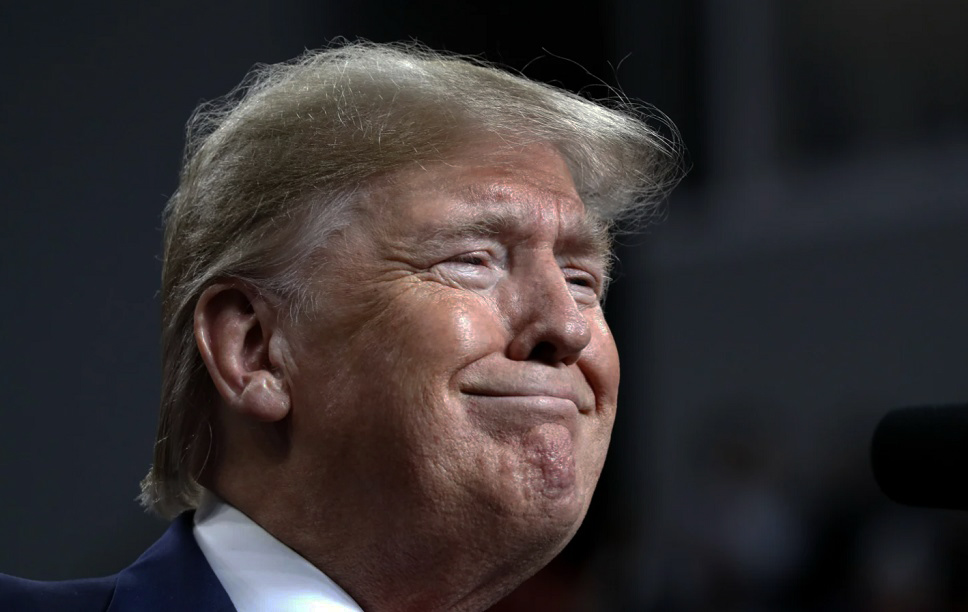
WASHINGTON—Donald Trump’s plans to establish a virtual dictatorship should he win the White House again in the 2024 election are even worse than we thought. Call it the presidency uber alles.
Trump would suspend parts of the Constitution, as he threatened to do to keep himself in power. He’d replace the non-partisan civil service with political sycophants ready to do his bidding. And he’d claim the powers of the president are absolutely unlimited, as he did in 2019.
But according to the New York Times, he’d take over the judiciary, emasculate independent agencies such as the National Labor Relations Board, and virtually obliterate Congress’s power of the purse.
Indeed, you could make a plausible argument Trump has already taken over the judiciary, thanks to Senate Republican Leader Mitch McConnell of Kentucky, and the right-wing Federalist Society.
The society’s gray eminence, Leonard Leo, sat in the White House rating the hundreds of judicial nominees—including three Supreme Court justices—Trump seated on federal benches. If they passed ideological litmus tests, black robes were their reward.
One of them, a Federalist Society member, is Aileen Cannon, the Florida federal judge now presiding over Trump’s trial in the purloined White House secret papers case.
And just to make sure he’d get away with all of this, Trump argued in federal appeals court last December that a president has absolute immunity from any prosecution for anything, according to the Constitutional Accountability Center, which successfully opposed him.
There’s a key difference between now and when Trump entered the Oval Office in 2017. Then, he had no structure in place to implement his dictatorial aims. Indeed, his White House was rather slapdash. And it kept losing “power” cases in the federal courts.
Now, starting in 2021, a think tank, the America First Policy Institute, run by former Trumpite officials, has put together position papers on policies he can implement. Both the Times and Vanity Fair have delved even further into Trump’s dictatorial plans. Here’s what they found:
- Trump bases his plans on “a maximalist version of the so-called unitary executive theory,” says Vanity Fair. “The legal theory rejects the idea the government is composed of three separate branches with overlapping powers to check and balance each other.
“Instead, adherents argue that Article 2 of the Constitution gives the president complete control of the executive branch, so Congress cannot empower agency heads to make decisions or restrict the president’s ability to fire them.” One adherent: Trump. He told a campaign crowd in 2019 that Article 2 of the Constitution means the president can do whatever he wants
- Replacing the non-partisan, non-political civil service with political hacks at the top and workers cowed into submission below them, doing Trumpite bidding at the risk of being fired.
“The president’s plan should be to fundamentally reorient the federal government in a way that hasn’t been done since FDR’s New Deal,” former Trump White House Office of Personnel Management chief John McEntee told the Times. McEntee charged liberals created the federal bureaucracy to implement their goals, claiming a Trump takeover doesn’t mean just changing the names, but changing the structure by “a complete system overhaul.”
McEntee and the right-wing Heritage Foundation are leading a $22 million Project 2025 “preparing policies, personnel lists, and transition plans to recommend to any Republican who may win the 2024 election,” Vanity Fair reported. The scale of the project “is unprecedented in conservative politics.”
“The notion of independent federal agencies or federal employees who don’t answer to the president violates the very foundation of our democratic republic,” said Heritage President Kevin Roberts. Project 2025 backers “are committed to dismantling this rogue administrative state,” he told Vanity Fair.
Trump campaign spokesman Steven Cheung was blunter. One of Trump’s aims, he said, would be to “eradicate the deep state that works against Americans once and for all.”
The Trumpite America First Policy Institute hides that goal in an innocuous statement: “The federal government currently regulates almost every aspect of Americans’ lives—crowding out the ability of individuals, communities, and states to make decisions themselves. This was not the founders’ original vision. Instead, they conceived of a federal government that would tackle only truly national responsibilities such as national defense or regulating interstate commerce.”
- Truncate Congress by impounding money it allots and diverting it for his own purposes. When in power, that’s how Trump wanted to fund his racist Mexican Wall. Congress and the courts stopped him. Congress outlawed impoundment as part of its post-Watergate reforms.
This time, the Republican version of the money bill for the Homeland Security Department legalizes that very diversion, transferring billions to the wall, and away from combatting global warming.
- Packing the judiciary with right-wing ideologues in black robes. To some extent, and with McConnell’s deliberate help—the Republican leader made judgeships the chamber’s top priority from 2017-21—Trump’s already done that.
Federalist Society honcho Leonard Leo, sitting in Trump’s White House in those years, approved 226 appeals court judges alone. He also OKd hundreds more federal District Court judges, who actually handle trials, including Cannon.
- Ending Justice Department “independence” from White House control. Such control was rife during Republican President Richard Nixon’s regime and before. Under Nixon, it extended to Assistant Attorney General Henry Petersen directly reporting on the FBI’s Watergate investigation to White House Counsel John Dean and other top Nixon aides.
That arrangement stank so much that President Gerald Ford had to appoint an obviously non-political and non-partisan Attorney General, Edward Levi, the University of Chicago president and its former law school dean, to clean up the mess.
After Levi left, other Attorneys General were supposed to follow in that tradition, and presidents were expected to honor it. Trump didn’t, naming first Sen. Jeff Sessions, R-Ala., then prominent D.C. attorney Bill Barr—who flatly lied about the results of the first impeachment investigation of Trump. Barr resigned in protest after Trump ignored Barr’s blunt evaluation that no vote fraud occurred and Trump had lost the 2020 presidential election to Joe Biden.
- “Scour the intelligence agencies, the State Department, and the defense bureaucracies to remove officials he has vilified as ‘the sick political class that hates our country,’” says Vanity Fair.
This is a variation on a long-time Republican tirade against “pointy-headed bureaucrats,” especially in the diplomatic corps. And Trump’s mistrust of the intelligence agencies was obvious all through his prior term.
As for the military, Trump’s Defense Secretaries grew so alarmed at his actions, and inactions, leading up to the Jan. 6, 2021, Trumpite invasion, insurrection, and attempted coup d’état at the U.S. Capitol, that they took steps to break the chain of command and keep it in their hands, not his.
In all likelihood, those military men knew of the recommendation by Michael Flynn, the former general whom Trump had named his National Security Advisor—before being forced to push him out—to declare martial law in order to hang onto the Oval Office.
We hope you appreciated this article. At People’s World, we believe news and information should be free and accessible to all, but we need your help. Our journalism is free of corporate influence and paywalls because we are totally reader-supported. Only you, our readers and supporters, make this possible. If you enjoy reading People’s World and the stories we bring you, please support our work by donating or becoming a monthly sustainer today. Thank you!










